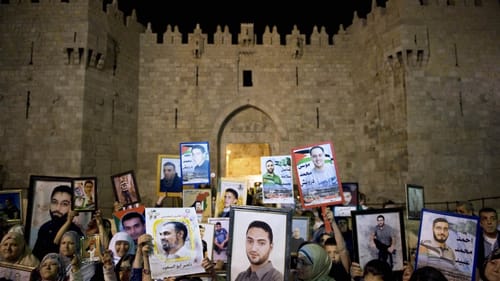Stay in the Loop
BSR publishes on a weekly schedule, with an email newsletter every Wednesday and Thursday morning. There’s no paywall, and subscribing is always free.
Witness, wake-up, wound
Slought gallery presents ‘The Image-Event: A Joint Struggle’

This is what occupation looks like: Among the photos from the Slought gallery’s The Image-Event: A Joint Struggle, a Palestinian youth lobs a stone at an Israeli bulldozer during a protest. Muslim worshippers crouch in prayer as Israeli police in riot gear block their way to the Al Aqsa mosque.
A Jewish settler in Hebron dresses mockingly as a Palestinian prisoner (a region-specific version of “darkface,” with the man’s skin mottled with makeup) for a West Bank Purim parade. A group of men, heads capped with kippot, prayer-shawl fringes dangling beneath their black jackets, gather on the roof of a seized Palestinian home, celebrating Chanukah with gigantic cardboard candles.
But the most telling images may be the ones we can’t actually discern. One large montage shows eight photos—each occluded with tangles of dark spray paint—plastered to a wall that is painted with a mural of leaves. Someone found these images so volatile that they felt compelled to blot them out.
A collective perspective
ActiveStills, the collective of Palestinian, Israeli, and international photographers who made this exhibit, aims to “show Palestinian life under military control and ongoing dispossession.” It’s a perspective not often seen in US mainstream media, which tends to zoom in when tensions erupt in airstrikes or a suicide bomb but not to chronicle relentless suffering in the occupied West Bank and in Gaza, where an Israeli blockade clamps the movement of people and goods.
The ActiveStills photographers met in 2005 in Bil’in, a West Bank site of weekly Friday protests by Palestinians joined by Israeli and international activists. They intend their work to be a catalyst for social and political change; that’s why they mount street exhibitions of their photographs and share their archive with activist groups for use in protests and publications.
That’s also why several images in the exhibit capture a layered complexity: We are looking at photographs of people viewing these photographs… or, in several cases, at the ways passersby have ripped or scrawled on the images as they hang in public spaces. I can’t read Hebrew, but captions note that the scrawls are racist terms.

“Not our Judaism”
One montage includes: two women in headscarves clinging to each other in anguish; a taxi with what looks like a whole family’s luggage piled on top; a line of people pinned between a high wall and a wire fence. We also see an older man looking at those images, one hand cupping his face—in shock? in despair? in rage? Because we view him from the back, we can’t know his feelings, or his ethnicity. The unreadable gesture reminds me that a photograph is never neutral; we see it, always, through our own pained lens.
One of the most devastating montages in the show, The Obliterated Families of Gaza, includes 13 images with snapshots of people killed during Israel’s 2014 siege against Gaza—photos pinched between survivors’ fingers, arranged on gravel or propped on the ledge of a mirror in which a young man gazes at the blurred faces of 10 dead relatives.
If there is hope depicted in this exhibit, it lies in the many photos of resistance: protests not only against the occupation but against deportation and racism, and in support of LGBTQ and immigrant rights. In one, Jewish activists hoist a banner reading, in English, “Segregation Is Not Our Judaism.”
The common human cost

These photos serve as witness, as wake-up, as wound. As I looked at them, painstakingly matching the numbered captions to each corresponding shot, I wished for more text, more context: not a stab at fairness by depicting the “other side” but a wider perspective—a map of the area, for starters (we’re talking about a region approximately the size of New Jersey) and a timeline of key events. Such a timeline could begin with the 19th-century anti-Semitic violence across Europe that prompted so many Jews to leave in a desperate search for safety, and could include the 1948 declaration that meant statehood for one people, catastrophe for the other and perpetuation of a decades-long conflict that, in the words of ActiveStills photographers, “continues at great human cost."
While moving from photo to photo—funerals and checkpoints, protests and prayer, roadblocks and home demolitions and efforts by activists to rebuild those same homes—I had a recurring thought: Take away the kippot and the checkered kaffiyehs, strip the photos of their flags and signs in Arabic or Hebrew, and what is left are human beings—olive-skinned, sorrowful-eyed, two traumatized tribes who, for more than a century, have never been able to acknowledge one another’s pain.
In a photo of a burning Palestinian home, flames tear across a landscape, inches away from several lines of laundry. I thought about a poem by the Palestinian-American writer Naomi Shihab Nye: “This bundle of clothes we wash and hang and wash again / like flags we share, a country so close / no one needs to name it.”
Those about-to-be-singed shirts and pants could belong to anyone. The wall has not brought peace. The people on both sides look like cousins. Like mine.
An earlier version of this article mis-identified the group ActiveStills as ArchiveStills. We regret the error.
What, When, Where
The Image-Event: A Joint Struggle. Through March 31, 2019, at Slought, 4017 Walnut Street, Philadelphia. (215) 701-4627 or slought.org.
Sign up for our newsletter
All of the week's new articles, all in one place. Sign up for the free weekly BSR newsletters, and don't miss a conversation.

 Anndee Hochman
Anndee Hochman